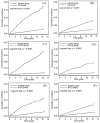Patients with urothelial carcinoma have poor renal outcome regardless of whether they receive nephrouretectomy
- PMID: 27533250
- PMCID: PMC5308682
- DOI: 10.18632/oncotarget.11223
Patients with urothelial carcinoma have poor renal outcome regardless of whether they receive nephrouretectomy
Abstract
The association between urothelial carcinoma (UC) and subsequent ESRD incidence has not been confirmed. This was a population-based study using claims data from the Taiwan National Health Institutes from 1998 to 2010. The study cohort consisted of 26,017 patients with newly diagnosed UC and no history of ESRD, and the comparison cohort consisted of 208,136 matched enrollees without UC. The incidence of ESRD was ascertained through cross-referencing with a registry for catastrophic illnesses. Cox proportional hazard regression analysis was used to estimate the risk of ESRD associated with UC and UC subtype. A total of 979 patients (3.76%) from the UC group and 1,829 (0.88%) from the comparison group developed ESRD. Multivariable analysis indicated that compared with the comparison group, the hazard ratios (HRs) for ESRD were 7.75 (95% confidence interval [CI]: 6.84 to 8.78) and 3.12 (95% CI: 6.84 to 8.78) in the cohort with upper urinary tract UC (UT-UC) and bladder UC (B-UC), respectively. In addition, there were significantly increased risks for ESRD in UC patients receiving and not receiving nephrouretectomies or aristolochic acids (AA). Moreover, the UC patients receiving segmental ureterectomy and ureteral reimplantation had approximately 1.3-fold and 2.4-fold increased risk for ESRD after control for confounders, respectively. Thus, our data indicate that UT-UC and B-UC independently increased the risk for ESRD in patients after considering about nephrouretectomies or aristolochic acids (AA). In addition, UC patients receiving segmental ureterectomy and ureteral reimplantation had increased risk for ESRD.
Keywords: chronic kidney disease; end stage renal disease; nephrouretectomy; urothelial carcinoma.
Conflict of interest statement
The authors have no conflicts of interest to disclose.
Figures
Similar articles
-
Upper urinary tract urothelial carcinoma behaviors in patients with end-stage renal disease after kidney transplantation in Taiwan.Int Urol Nephrol. 2016 Aug;48(8):1261-1265. doi: 10.1007/s11255-016-1308-x. Epub 2016 May 18. Int Urol Nephrol. 2016. PMID: 27193437
-
Higher risk of urothelial carcinoma in the upper urinary tract than in the urinary bladder in hemodialysis patients.Ren Fail. 2016 Jun;38(5):663-70. doi: 10.3109/0886022X.2016.1155392. Epub 2016 Mar 8. Ren Fail. 2016. PMID: 26956094
-
Increased risk of urothelial cancer in young and middle aged patients with end-stage renal disease.J Formos Med Assoc. 2015 Jan;114(1):52-7. doi: 10.1016/j.jfma.2013.10.022. Epub 2013 Dec 18. J Formos Med Assoc. 2015. PMID: 24360022
-
Oncologic Outcomes of Post-Kidney Transplantation Superficial Urothelial Carcinoma.Transplant Proc. 2018 May;50(4):998-1000. doi: 10.1016/j.transproceed.2018.01.031. Transplant Proc. 2018. PMID: 29731099
-
Association between urologic malignancies and end-stage renal disease: A meta-analysis.Nephrology (Carlton). 2019 Jan;24(1):65-73. doi: 10.1111/nep.13209. Nephrology (Carlton). 2019. PMID: 29236344
Cited by
-
Safety and Efficacy of Immune Checkpoint Inhibitors for Patients With Metastatic Urothelial Carcinoma and End-Stage Renal Disease: Experiences From Real-World Practice.Front Oncol. 2020 Nov 27;10:584834. doi: 10.3389/fonc.2020.584834. eCollection 2020. Front Oncol. 2020. PMID: 33330066 Free PMC article.
-
Integration of medicinal plants into the traditional system of medicine for the treatment of cancer in Sokoto State, Nigeria.Heliyon. 2020 Sep 2;6(9):e04830. doi: 10.1016/j.heliyon.2020.e04830. eCollection 2020 Sep. Heliyon. 2020. PMID: 32939417 Free PMC article.
References
-
- US Renal Data System USRDS 2012 Annual Data Report: Atlas of Chronic Kidney Disease and End-Stage Renal Disease in the United States. Am J Kidney Dis. 2012 - PubMed
-
- Kuo HW, Tsai SS, Tiao MM, Yang CY. Epidemiological features of CKD in Taiwan. Am J Kidney Dis. 2007;49:46–55. - PubMed
-
- Haroun MK, Jaar BG, Hoffman SC, Comstock GW, Klag MJ, Coresh J. Risk factors for chronic kidney disease: a prospective study of 23,534 men and women in Washington County, Maryland. J Am Soc Nephrol. 2003;14:2934–2941. - PubMed
-
- Hung PH, Shen CH, Chiu YL, Jong IC, Chiang PC, Lin CT, Hung KY, Tsai TJ. The aggressiveness of urinary tract urothelial carcinoma increases with the severity of chronic kidney disease. BJU Int. 2009;104:1471–1474. - PubMed
-
- Maisonneuve P, Agodoa L, Gellert R, Stewart JH, Buccianti G, Lowenfels AB, Wolfe RA, Jones E, Disney AP, Briggs D, McCredie M, Boyle P. Cancer in patients on dialysis for end-stage renal disease: an international collaborative study. Lancet. 1999;354:93–99. - PubMed
MeSH terms
Substances
LinkOut - more resources
Full Text Sources
Other Literature Sources
Medical


